
15 minute read
PRO-ACTIVE DOWNTOWNS
6 ways downtowns are helping merchants during the pandemic
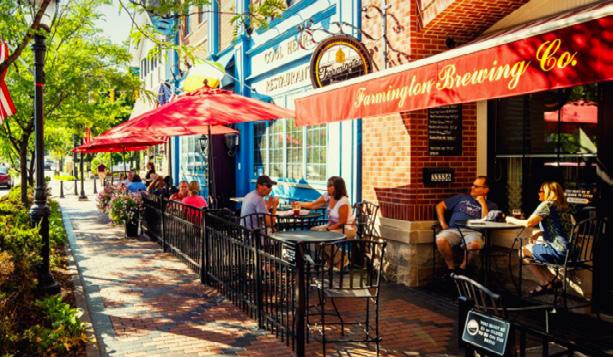
Far left: Clawson held a sidewalk sale that had two dinosaurs handing out fun face masks to kids. Near left: Farmington bought umbrellas for outdoor seating.
Opposite page, top: Dearborn started a “Love Your Local” promotion. Opposite page, bottom: Northville closed its main street to let retailers sell merchandise outside.
By SHANDRA MARTINEZ
Whether it’s providing access to experts or adding more outdoor seating, downtowns across Michigan are finding creative ways to support small business during the global pandemic.
With restrictions that limit the number of shoppers inside buildings, taking advantage of outdoor space has been crucial.
There are many ways Downtown Development Authorities can support retailers, according to Dana Walker, Michigan Downtown
Association director. As people feel more comfortable dining al fresco, Walker suggests DDAs consider an effort to keep those people downtown.
“We’ve had to use a really wide variety of tools to try to address each business’ specific, unique needs,” said Lori Ward, director of the Northville DDA. “I think we’ve done a pretty good job of trying to give everybody an opportunity to succeed, so that’s exciting.”
Here are some other ways DDAs and other organizations are supporting merchants across the state: 1. SOCIAL DISTRICTS. Grand Rapids, Northville, Cadillac and
Muskegon are among the communities taking advantage of newly passed legislation enabling carryout options for alcoholic drinks from restaurants and bars. It also gives local governments the power to create social districts that allow participating restaurants and bars to obtain a special permit to sell alcohol that can be consumed in the common areas of the downtown.
Muskegon expects to launch its social district this fall and expand it by several square blocks in the spring. “This is a new tool to get more people out and about. We want to create a permanent street festival atmosphere downtown,” said Dave Alexander, Muskegon
DDA’s business development manager.
Northville dubbed its social district “The Twist,” inspired by its logo touting Northville as “timeless ... with a twist.” The social district includes two closed streets connected to the downtown’s two plazas, now filled with moveable tables and chairs. “Normally, we 12 have yoga classes and performances there, but this summer we really wanted to leave the plazas for our residents and our visitors
just to have a kind of safe haven that they could control,” Ward said. 2. GRANTS. Dearborn (which consists of East and West DDAs) partnered with local nonprofits to provide $150,000 in grants to help 70 of the city’s small businesses. Most of the grants were between $2,500-$5,000. The collaboration pumped money back into the downtown.
The Michigan West Coast Chamber of Commerce, which serves the neighboring communities of Holland and Zeeland, offered grants of up to $10,000 to struggling businesses through its foundation to help pay rent and utilities.
3. EXPERTISE. Farmington’s DDA partnered with a local attorney, who offered a 30-minute free consultation with merchants to answer legal questions about a range of issues — from how to prevent evictions to dealing with vendors during the pandemic. Nearly a dozen businesses took advantage of the service, which is still available. The Farmington DDA also contracted with a liquor license advocate to help local businesses apply for permission to extend their liquor licenses to serve drinks outdoors.
Dearborn launched a business assistance team, partnering with more than 25 organizations from the University of Michigan-Dearborn to the Small Business Administration to provide a range of free resources. “This is something that we had been looking at doing for a while and, when we went into shutdown, we said, ‘We’ve got to get this up and running,’” said Cristina Sheppard-Decius, executive director of the East and West Dearborn DDAs. “This brings together a lot of resources that can help businesses look at things from a different angle and give them some good suggestions on what they can tweak.”
4. CAMPAIGNS. The city of South Lyon, Lyon Township and the Kensington Valley Chamber of Commerce are collaborating on a “Show Your Love For Lyon” campaign. It encourages the community to unite behind businesses and support them to generate some needed dollars for the local economy.
“We passed out free marketing kits to merchants with posters for windows and checkouts, stickers and an option to order T-shirts,” said DDA Director Nathan Mack. “We’re also doing an advertising campaign and feather flags and banners with our message, ‘Shop Local Dine Local.’” Dearborn spent more than $25,000 on “Love Your Local. Reimmerse in Commerce” campaign, featuring advertising, banners, window displays, sanitizing stations and campaign videos.
Other communities are reminding residents of the importance of supporting the local economy with signage and logos. There’s “Love Local Rochester” and Zeeland’s “Heal the Zeel.” In northern Ottawa County, Grand Haven, Spring Lake and Ferrysburg are doing versions of “For the Love of” community masks to encourage people to wear masks so businesses can stay open.
5. PROMOTING OUTDOOR SPACE. Traverse City and Northville were among downtowns that closed down streets, while other downtowns let merchants take over sidewalk and parking spaces. Northville used a special event application approved by the city council to close two streets to provide room for businesses to expand outdoors.
“We’re able to allow the retailers to move onto the sidewalk so that they could sell merchandise outside,” said Northville DDA’s Ward. “A lot of them really rose to the occasion. They put up beautiful displays, and


Northville also brought back live music every Friday and Saturday evening that’s meant to be background music while people dine and shop, rather than a performance that draws an audience. “We don’t have them on a stage where people will crowd in and just sit close to each other,” Ward said.
The city of Holland extended its outdoor expansion program through Dec. 1 so shops and restaurants can continue to use sidewalks and parking spaces. Milford created a program where restaurants could purchase decking that fits together like Legos to create expanded outdoor space. Milford Public Works installed the decks.
“We had to find a system that we could use fast and that is adjustable to different ground surfaces,” said DDA Milford Executive Director Ann Barnette, adding that a local builder suggested a floating paver system. Each paver can be adjusted up or down by two to four inches. “That allowed us to approve all the decks at once instead of individually, which saved a lot of time.”
Farmington spent money on umbrellas for outdoor seating at downtown restaurants and stores. “We wanted to create a district that was a destination,” explained Kate Knight, with Farmington’s DDA, which invested in the umbrellas, tables, chairs and containers to create a uniform look.
6. OUTDOOR ACTIVITIES. Several downtowns are using sidewalk sales to create outdoor shopping opportunities. Farmington did both a sidewalk sale and Girlfriends Night Out, with many merchants taking part and promoting the events.
Clawson held an Open Air Sidewalk Sale in August that featured eyecatching circus performers on unicycles and stilts. “We had a lot of activity along the sidewalks, and it was all planned out so people could keep moving,” said Clawson DDA Director Joan Horton, noting that two merchants teamed up to buy children’s masks decorated with dinosaurs and then had people dressed like dinosaurs hand them out. The DDA is planning another strolling event in October, she said.
While the challenges of the pandemic have resulted in some downtown businesses closing, there have also been businesses expanding and trying out new concepts.
“I have been blown away by the creativity and the resilience of some of the retailers in the downtown,” said Northville’s Ward. “We’ve had three downtown businesses expand or open. I’m just awestruck that there are still people able to grow in this time.”
Some of the changes the DDA developed during the pandemic to help merchants might stick, like offering live background music instead of concerts.
“I think we’ve learned some things through this great experiment that we’ve been doing,” Ward said.
Looking toward the snowy season downtowns are looking at winter markets, over-the-top window displays, literal window shopping with QR codes for shoppers who want to buy on the spot, and lots of propane heaters for outdoor seating areas. Let us know what you plan and we may write about it in our December issue! Send your winter activation plan to Meegan Holland at mholland@retailers.com.
What goes into a
Eye-popping or thought-provoking, art draws attention to your store
Story by MEEGAN HOLLAND Photos by DAVID TRUMPIE
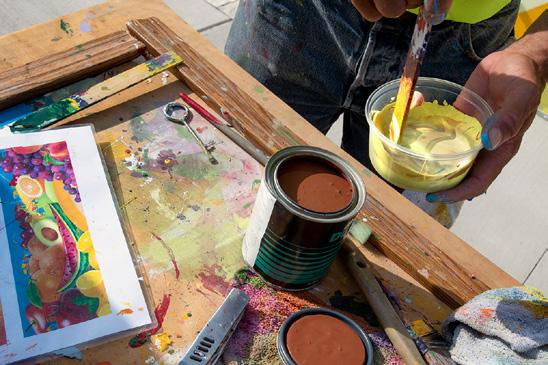
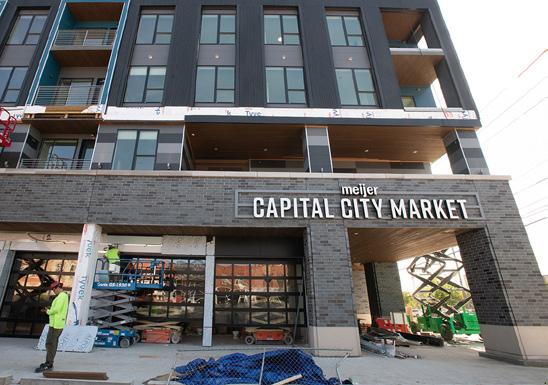
Several Michigan communities have been seeing murals pop up all over their downtowns for the past couple years. The art form has exploded in popularity after some cities started projects that brought in artists from around the nation – even the globe – for festivals that decorated walls of commercial districts.
It happened in Jackson, with the “Bright Walls” festival, and last year in Lansing, with its “Below the Stacks” painting marathon.
Now another mural will add to the 10 that came to fruition through the Below the Stacks festival: A brightly colored cor
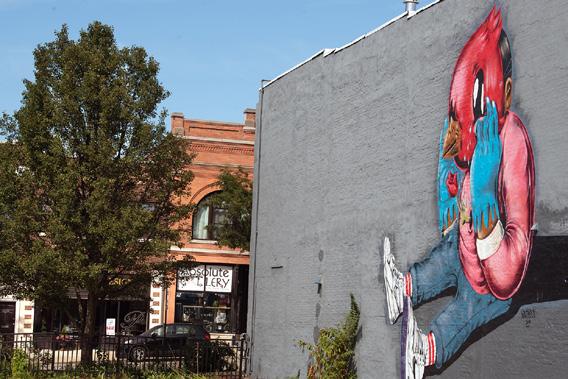
nucopia of fresh fruits and vegetables that spills across the massive back wall of the new Meijer-owned Capital City Market in downtown Lansing, an urban grocery store scheduled to open in mid-October. Since mid-August, artist Brian Whitfield has been in a hard hat and often on a lift, working alongside the construction crews as they all put finishing touches on the building.
The Capital City Market mural makes for an eye-popping, cheerful entrance to shoppers from the back parking lot, especially on a gray winter day.
“Meijer is committed to enriching lives in the communities we serve, and art is a great way to express those ties,” said Mitch Cook, store manager. “As you can see with our mural, it shows that our store will help lift the community and businesses by offering fresh food in downtown Lansing, filling a need.”
The building developer, Lansing-based Gillespie Group, is known for incorporating color into its building facades. They helped Meijer go a step further with this mural.
“We believe that art is truly important in strengthening any culture and city,” said Ashley Brzezinski, director of marketing for Gillespie
Left: For Lansing’s Below the Stacks mural festival, the artist Sentrock added to his array of murals featuring variations of this bird. His motto: “Bird don’t fly in the cage, sun don’t shine in the shade.”
1. Artist Brian Whitfield mixes paint colors for a mural Meijer’s Capital City Market in Lansing. 2. The street side of the store, which opens in mid-October. 3. Whitfield rented a lift to paint the massive work on the store’s back wall. This photo shows only half the mural.
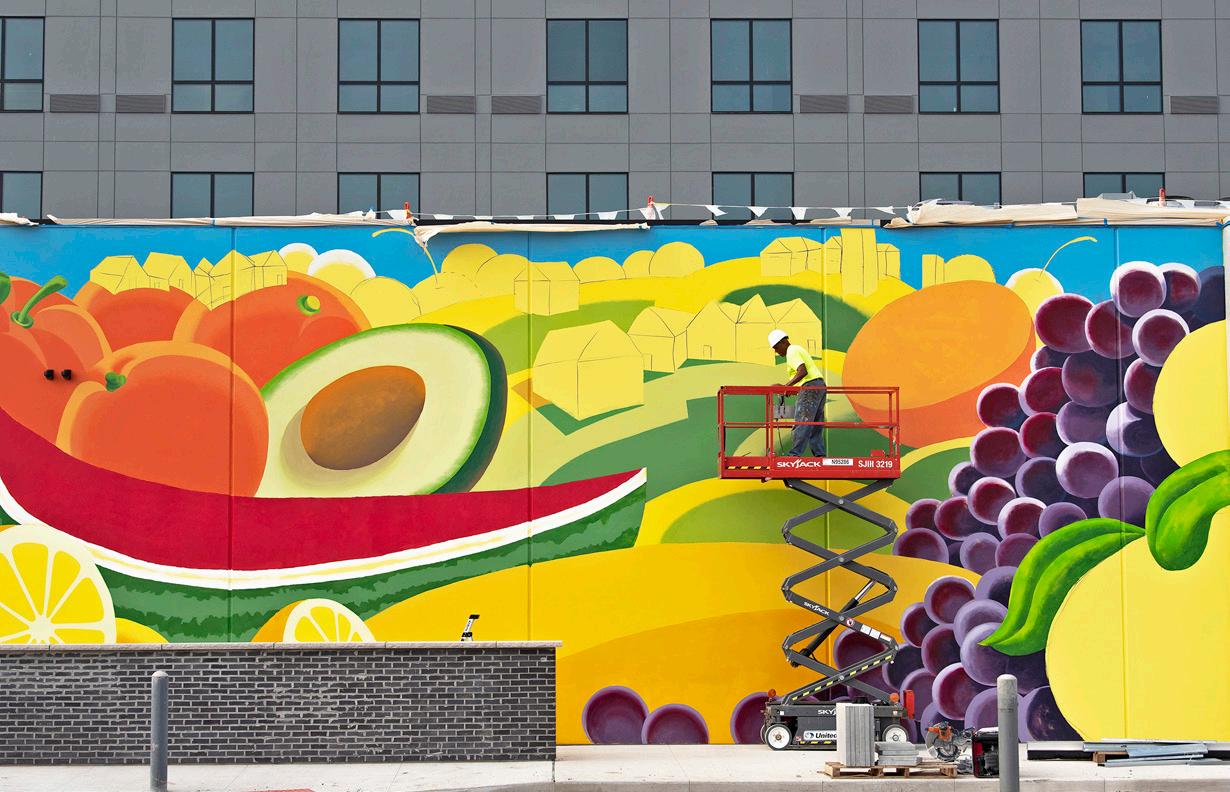
Change photo
Group. “It communicates the heart of the people that make up the community. We love what the local artists are doing to add vibrancy to spaces through murals and art pieces.”
Partnerships are often what lead to murals that grace the sides of buildings. The Jackson Young Professionals partnered with several organizations to bring together muralists for the Bright Walls Festival in 2018, which helped draw attention to the downtown. It was repeated in 2019, and was going to be revived for 2020 until the pandemic hit. The results have been so stunning that the Chicago Tribune named the small, southern Michigan city as one of the 10 best Midwest places to visit in 2020.
Another notable partnership can be found in East Lansing, the only Michigan city to have a “Percent for Art” program, which requires developers to contribute one percent of their development costs, or a minimum of $25,000, to a work of public art. It could be a sculpture, but some have chosen murals.
If you’re a store owner with a blank wall screaming for a mural, such a partnership may be the way to go. Check with your regional arts council for information about grants or other ways to help fund a mural. Many also have lists of artists who paint murals, if you have the budget and a plan ready to go. the Capital City Market mural, says you want to have some concept in mind before approaching an artist. Murals often depict topics that have nothing to do with the store – but they draw eyeballs to your building, and that’s a good thing. Curious about concepts? Just Google “Bright Walls in Jackson” or “Below the Stacks in Lansing” to see the over-the-top subject matter.
Many artists will encourage you to think beyond the obvious icons in your town. The East Lansing Arts Commission, for example, often tells developers that no, they don’t have to incorporate Sparty or other MSU symbols into the artwork.
Murals can be eye candy, or thought-provoking – it depends on what message you want to send. “As a retailer, you may not want to offend any customers. Or you may want to make a statement and say, ‘This is us and this what we’re going to do.’ But then you need to be prepared to deal with any blowback,” says Whitfield, who has done historic-oriented murals in Lansing, but also more abstract topics. He also has done interior murals, which are a good alternative if you don’t have the budget or a wall for an exterior mural.
“A mural can simply be a doorway,” he said.
For your Request for Proposal (RFP), you need to have an
accurate measurement of the wall and detail about any windows, electrical boxes or other infrastructure. “The more accurate you can get, the better because then the artist doesn’t have any surprises and doesn’t have to redesign the concept,” says Whitfield.
Once the artist is chosen, several factors go into pricing. Some artists charge by the hour. Whitfield opts to charge by the square footage and the complexity of the mural, because he wants flexibility on time to get the mural done right. If you want a detailed portrait of a person, that will be much more expensive than a mural with large print or a clean-lined landscape, for example. Prices could range from a very low $10/square foot up to $25/square foot.
You’ll also need to decide who pays for supplies – does the artist absorb the cost of paint, a lift if needed and the graffiti protective coating? Who primes the wall? Whitfield suggests using a highquality paint, because the mural will last longer.
And of course, make sure everybody is properly insured for liability.
Once the artist sketches the mural or designs it on a computer, be sure to have several sets of eyes on it to ensure something doesn’t unintentionally become the story. Whitfield recalls when someone spotted a phallic image in a bowl of spaghetti that he had sketched for a historic mural that was to grace a block that once had a longtime Italian restaurant. He was shocked because it was totally unintentional, “but once you saw it, you couldn’t un-see it!”
Whitfield worked closely with Meijer on the subject matter. He initially had people in the mural, but those came out. Small houses stayed in after some debate among Meijer folks.
“I’m a graphic artist, so I put my graphics arts hat on with a mural - whatever the client wants, you just use your skills to give them what they want. As a fine artist, you can say, ‘I do whatever I want and you accept it.’”
Whitfield is a graphic artist for the Michigan Department of Transportation; his design for the Mackinac Bridge license plate was voted the world’s best new plate by the Automobile License Plate Collectors Association in 2014. He’s also an accomplished fine artist and has sold many pieces through galleries. He was trained

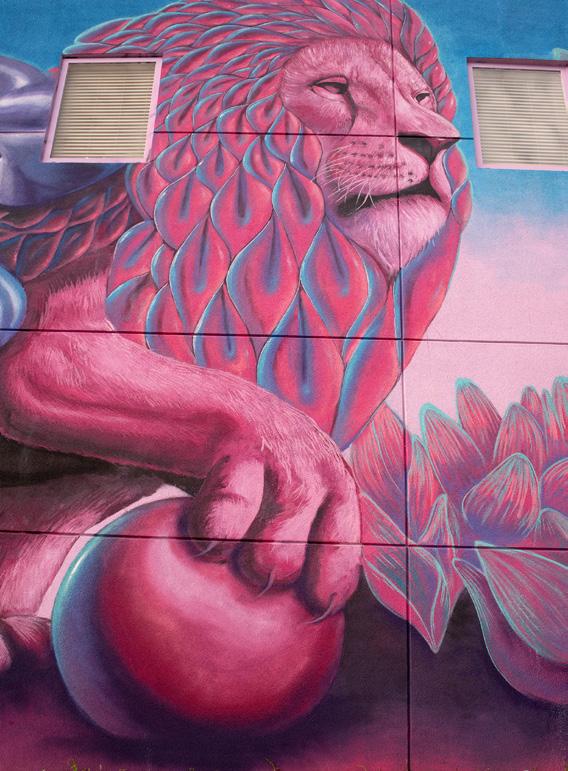
at Kendall College of Art & Design and earned an MFA in painting from Maryland Institute College of Art.
He also suggests giving the artist flexibility on time. For this interview, Whitfield was just finishing up the fruit side of the Meijer Capital City Market mural and looking at the vegetable side. He had hand brushed all of it, and sometimes twice for complete coverage.
“I can paint from early morning, with a short break in the middle until it gets dark if everything is clicking. If it’s not going well, then mentally you can break down. The apples, mentally, were a struggle. It was really hot and things weren’t going right. Paint was drying too fast and the colors weren’t coming out right. But when things are clicking, you can just keep going.”
And if you want to change the design mid-course, just know that’s not easy. “If a mural requires a change, you have to do a lot of planning, while a piece of fine art is easier to improvise,” he said.
Once the mural is done, you need to honor it with proper lighting and landscaping. Too many murals go to waste in dark parking lots overgrown with weeds.
Murals have a life cycle. If you want one to last for years, a store owner must be prepared to maintain it – and pay someone to do so. Most artists want right of first refusal to maintain, repair or change their own mural if necessary.
Opposite page, top: The artist Werc, from Texas and Mexico, often paints exotic animals. This appears on a main thoroughfare in Lansing, and was done during the Below the Stacks festival. Opposite page, bottom: Elderly Instruments, a be- loved stringed instrument store in Lansing, graced the side of its building in 2015 with a mural that reflects the store’s vibe. It was created by Jennifer Springman.
This page, top: An MSU artist in residence, Nanibah Nani Chacon, painted this in Lansing’s Old Town to re- flect the neighborhood’s Latino roots. This page, bottom: Old Town Lansing’s jazz and blues festivals are honored in this mural, a collaboration with art students and muralists.
Ideal timeline for installing a mural
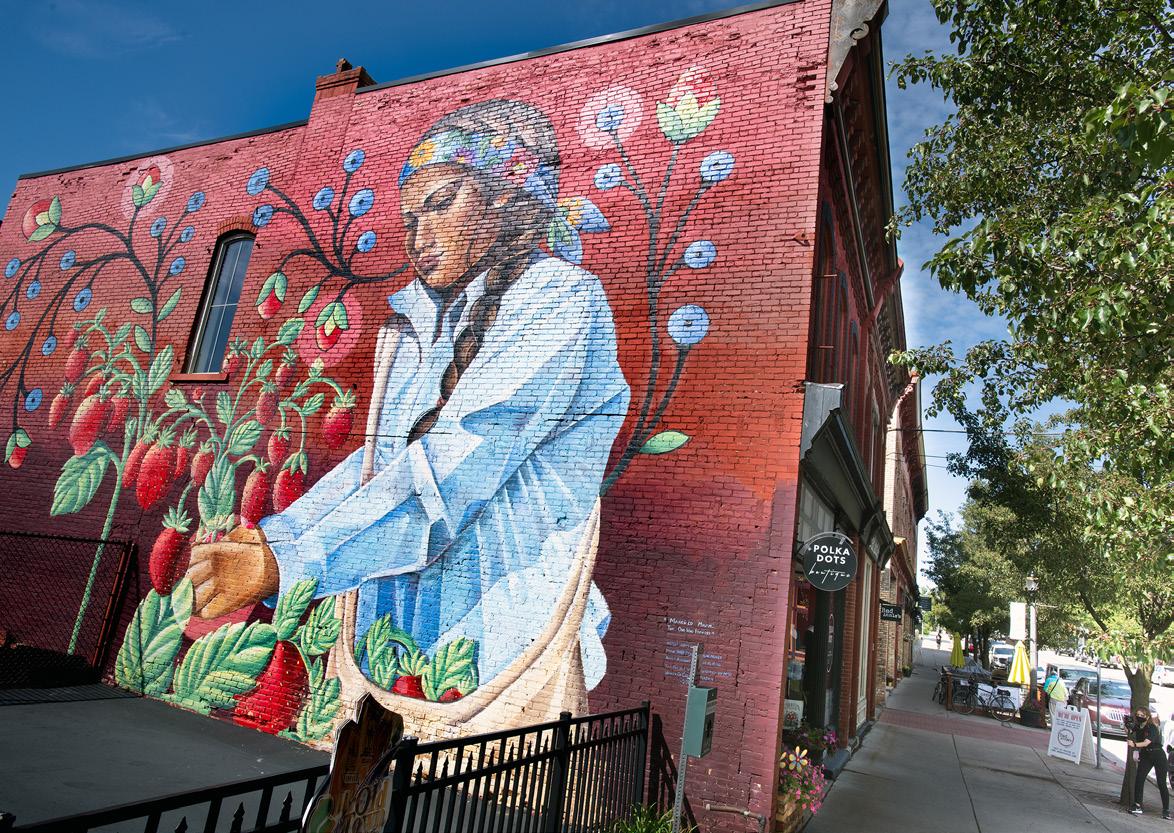
August
Start fleshing out the concept (provocative or customer oriented?)
September
Finding an artist (Arts council, for example.) Put out an RFP with a deadline of late October
November
Choose artist and negotiate price
December-April
Go back and forth with artist to refine sketch
May-June
The mural is painted
June
Schedule your grand reveal!







